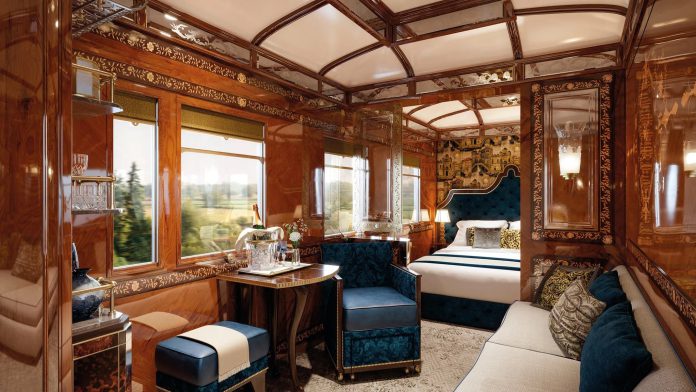You might recall the iconic Orient Express from author Agatha Christie’s eponymous thriller The Murder On the Orient Express. The plot of the novel follows the discovery of a murder aboard the train and its meticulous unravelling by popular fictional detective Hercules Poirot. While the major thread running through the novel is reminiscent of Christie’s classic thriller genre, an aspect that makes it stand out from her other novels is its uncharacteristically intricate descriptions of the scene of the crime, the opulently decked train. The opening chapters of the novel take the readers through a stunning description of the regal interiors of the passenger train. These interior designs portray an exquisite blend of 1920s aesthetics with contemporary styles. The fastidious attention paid to elements adorned with ornamental detail culminates into a tasteful piece of art.

HISTORY OF THE ORIENT EXPRESS
On a bright spring day in June 1883, the first Express d’Orient left Paris for Vienna. Vienna remained the terminus until October 1883, post which the train was officially renamed the Orient Express. Throughout its operation, the long-distance passenger train services were repeatedly disrupted due to multiple geopolitical stalemates among the countries through which it ran. For instance, at the height of both the First World War and Second World War, the Orient Express services had to be indefinitely terminated owing to untenable battlefield conflict, and it wasn’t resumed until the cessation of hostilities. Despite these setbacks, the Orient Express continued to thrive during peacetime. The 1930s saw the Orient Express services reaching its zenith in terms of popularity, with three parallel services running alongside each other: the Orient Express, the Simplon Orient Express, and also the Arlberg Orient Express, which ran via Zürich and Innsbruck to Budapest, with sleeper cars running onwards from there to Bucharest and Athens. During this time, the Orient Express acquired a stellar reputation for its comfort and cuisine. It counted among its patrons the royalty, aristocracy, and the bourgeoisie in general among others.
But with the arrival of convenient, ultra-modern means of transport, the Orient Express slowly began to lose its sheen, with services finally winding up in late 2010.

REVIVAL OF THE ORIENT EXPRESS
The French hospitality group, Accor, which holds a 50 per cent stake in the Orient Express brand, has announced that it plans to restore the original luxury convoy. It is believed that the services will start in 2024. The route of travel will follow the original trail, beginning from Paris and terminating in Istanbul, crisscrossing the entirety of Europe along the way.
For initiating the restoration process, Accor hired industrial historian Arthur Mettatal to hunt down the original carriages that had been taken off the grid after the services wound up. After much research, he and his team finally located the abandoned carriages in a deserted steppe on the border between Poland and Belarus. This expedition was undertaken with the aim to retain as much of the original elements as possible and so it was felt that procuring these carriages might aid the cause. “We were expecting them to be in terrible condition, but inside they were surprisingly well-preserved,” recounts a member of the team. “Some of them still had the original Lalique glass panels that were so emblematic of the Orient Express. We also found Morrison and Nelson marquetry,” which are intricate wood carvings with inlays of precious materials like gold or ebony. “The Art Deco details were just incredibly vibrant,” he says.

It is believed that the project will be completely redone in the tradition of the iconic French craftsmanship style. Accor for this purpose has collaborated with French architect Maxime D’Angeac. The architectural designer is known for some of his most illustrious pieces of work, produced in partnership with French fashion houses. He was tasked with an ostensibly simple assignment: to bring out the best of French artisanal excellence.

To achieve that, he approached the problem in two different ways: “I had to respect two key elements in this formidable project,” he says. “Extending the spirit of innovation that characterised the original train and reinventing the concept of comfort and luxury for the 21st century.” Operating within that strict framework, the carriage cars have been designed to incorporate the original intricate works.
For railway aficionados, the official website of the Orient Express now offers a compressive online tour of the train’s interiors that will give a peek into what one could expect from the project once completed.





